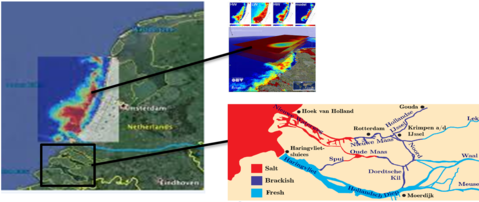Modelling flocculation and sinking rate of estuarine sediment
Modelling flocculation and sinking rate of estuarine sediment in Rhine Region of Freshwater Influence (Rhine-ROFI)
Estuaries are characterized as a mixing region of fresh riverine water and saline sea water. This mixing in combination of estuarine hydrodynamics provide a special physico-chemical conditions which favors the flocculation of fine sediment mentioned as Suspended Particulate Matter (SPM). These suspended particles (flocs) can have different size, mass, density, volume and shape depending on their composition and hydrodynamic shear stresses they experience. These differences, especially in the density and floc fractal dimension cause differences in their sinking rate. Accumulation of the theses flocculated matter on the bed creates a fluffy layer that can be easily re-suspended for instance by a storm event. The accumulated sediment in the harbor is removed annually by dredging. Therefore predicting the sinking rate and accumulation of SPM is important for harbor activities.
From ecological view, SPM is important for transport of nutrients, contaminant particles, light penetration and biological primary production. The models for SPM transport require estimation its settling behaviour.
This research aims to investigate the dynamics of flocculation and sinking rate of the SPM by studying floc formation mechanisms, floc composition and shear rate. In addition the resuspension of fluff layer and its interaction with the water column will be also studied for the Dutch coastal area.
The Dutch coastal area of the North Sea is characterizes by Region Of Freshwater Influence (ROFI) from Rhine and Meus rivers. The partially mixed estuary is formed by a network of waterways, harbour basins and river branches of the rivers Rhine, Meus and Scheldt, and salinity stratification is one of the most important physical process for SPM.
